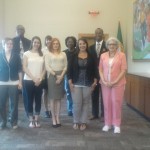The complex constellation of skills required for global leadership is continually morphing. The basic leadership competencies are only an axis around which revolve the specifics of local culture and the

analytics of the target culture globally. Therefore, not only does the knowledge management evolve, but so does the audience for global leadership development. At one time, the audience was primarily executives involved in international relocation. Over time, that group widened to include those who work with them: Human Resource departments, Supply Chain groups, and professionals with frequent contact, particularly in the STEM fields: Science, Technology, Engineering, and Math. Today, in order to stay competitive in this environment, virtually every nation on the face of the planet is extending their global leadership training into new arenas. A key area is our youth, brought up on the internet with its impersonal speed and no-holds-barred communication style. The question now becomes, how can we capture the imagination, thought processes, and commitment of potential leaders in an arena with few quick answers or short tweets.
Creating pilot projects that answer this question successfully is my current mission. Given my background in both cultural anthropology and urban planning, I have spent years devising training systems that rely on societal analysis and organization strategies. I divide the model that emerged into three major components, each using the methodology of the anthropologist/folklorist. The first component is Mindset: Inspiration to think globally and self/cultural-awareness. With a modified mindset in place, the second component is Problem Solving skills: Conflict Management strategies and wise Decision-making. Last, but in no way least; was Competence: Local-global acculturation strategies for Newcomers to a culture and those working with them.
Many of the readers of the American Diversity Report (ADR) were involved in our community Global Leadership Class and the Teen Global Leadership Class, helping to shape at the leadership model. A number of you have been involved as writers for the ADR, adding your knowledge and skill to the cumulative body of global wisdom. Years of field-testing the model resulted in a text book for global leadership development based on a storytelling model: Matrix Model Management System: Guide to Cross Cultural Wisdom. As the usage of the Matrix Model System increased, an accompanying Workbook was created to facilitate workshops in 1.) cross-cultural communication and 2.) problem solving.
The 3rd step was to apply the System to the Southern-Global connection, and thus, the next book was published, Going Southern: The No-Mess Guide to Success in the South. The combination of the Matrix’s Cross Cultural Wisdom and Going Southern strategies has emerged as a powerful tool for developing the global village in the South. The combination has been used to train and coach a wide variety of players including business executives, medical residents and staff, interns in social and government agencies, Human Resources managers, and entrepreneurs. Here are the 10 Must-Learn Strategies from the pilot project according to the summer interns 2014 of Chattanooga’s Office of Multicultural Affairs:
THE 10 MUST-LEARNS of GLOBAL LEADERSHIP TODAY
1. How to embrace the traits of wise Global lLeadership: Knowledge, Character, Vision, and Action.
2. How to manage knowledge and information across cultural lines.
3. How to understand that changing information details can change the communication process and outcome.
4. How to adjust for regional and national cultural differences in communicating with all parties involved.
5. How to successfully compromise and apply problem-solving strategies to future endeavors.
6. How to apply metrics to emotion, use stress-relief strategies, and deploy self-discipline during conflict.
7. How to acquire trust, implement transparency, and radiate humanity.
8. How to develop Inclusion through ongoing assessment and evaluation strategies.
9. How to articulate a Vision using planning tools: Mission, Goals, Objectives, Tasks, and Time Lines.
10. How to activate and implement your Vision using leadership and management strategies.
- Inter-generational education needed now – by Deborah Levine - April 19, 2024
- Tracking our Terrorist Destructors – by Deborah Levine - April 19, 2024
- UNTOLD Stories of a World War II Liberator - April 10, 2024
